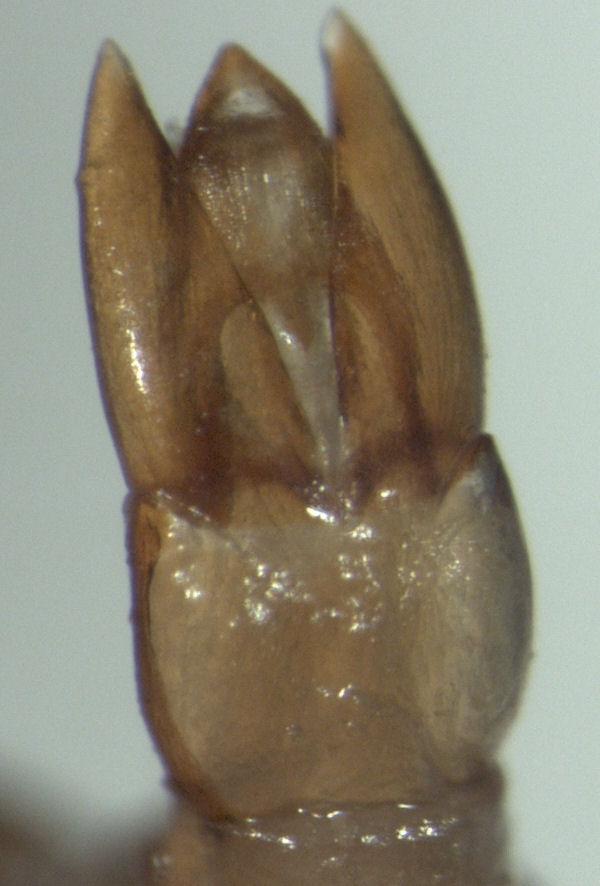Aedeagus on:
[Wikipedia]
[Google]
[Amazon]

 An aedeagus (plural aedeagi) is a reproductive organ of male
An aedeagus (plural aedeagi) is a reproductive organ of male

 An aedeagus (plural aedeagi) is a reproductive organ of male
An aedeagus (plural aedeagi) is a reproductive organ of male arthropod
Arthropods (, (gen. ποδός)) are invertebrate animals with an exoskeleton, a segmented body, and paired jointed appendages. Arthropods form the phylum Arthropoda. They are distinguished by their jointed limbs and cuticle made of chiti ...
s through which they secrete sperm
Sperm is the male reproductive cell, or gamete, in anisogamous forms of sexual reproduction (forms in which there is a larger, female reproductive cell and a smaller, male one). Animals produce motile sperm with a tail known as a flagellum, ...
from the testes
A testicle or testis (plural testes) is the male reproductive gland or gonad in all bilaterians, including humans. It is homologous to the female ovary. The functions of the testes are to produce both sperm and androgens, primarily testoste ...
during copulation
Sexual intercourse (or coitus or copulation) is a sexual activity typically involving the insertion and thrusting of the penis into the vagina for sexual pleasure or reproduction.Sexual intercourse most commonly means penile–vaginal penetra ...
with a female. It can be thought of as the insect equivalent of a mammal's penis
A penis (plural ''penises'' or ''penes'' () is the primary sexual organ that male animals use to inseminate females (or hermaphrodites) during copulation. Such organs occur in many animals, both vertebrate and invertebrate, but males do no ...
, though the comparison is fairly loose given the greater complexity of insect reproduction. The term is derived from Ancient Greek
Ancient Greek includes the forms of the Greek language used in ancient Greece and the ancient world from around 1500 BC to 300 BC. It is often roughly divided into the following periods: Mycenaean Greek (), Dark Ages (), the Archaic pe ...
αἰδοῖα (''aidoia'', "private parts") and ἀγός (''agos'', "leader"). It is pronounced or .
The aedeagus is part of the male's abdomen
The abdomen (colloquially called the belly, tummy, midriff, tucky or stomach) is the part of the body between the thorax (chest) and pelvis, in humans and in other vertebrates. The abdomen is the front part of the abdominal segment of the to ...
, which is the hindmost of the three major body sections of an insect. The pair of testes
A testicle or testis (plural testes) is the male reproductive gland or gonad in all bilaterians, including humans. It is homologous to the female ovary. The functions of the testes are to produce both sperm and androgens, primarily testoste ...
of the insect are connected to the aedeagus through the genital ducts. The aedeagus is part of the male insect's phallus, a complex and often species-specific arrangement of more or less sclerotized (hardened) flaps and hooks which also includes in some species the valvae (clasper), which are paired organs which help the male hold on to the female during copulation. During copulation, the aedeagus connects with the ovipore of a female. The aedeagus can be quite pronounced or ''de minimis''.
The base of the aedeagus may be the partially sclerotized phallotheca, also called the
phallosoma or theca. In some species the phallotheca contains a space, called the endosoma (internal holding pouch), into which the tip end of the aedeagus may be withdrawn (retracted). The vas deferens is sometimes drawn into (folded into) the phallotheca together with a seminal vesicle.
The sperm of arthropod
Arthropods (, (gen. ποδός)) are invertebrate animals with an exoskeleton, a segmented body, and paired jointed appendages. Arthropods form the phylum Arthropoda. They are distinguished by their jointed limbs and cuticle made of chiti ...
s is not passed to the female as liquid with free-swimming spermatozoa
A spermatozoon (; also spelled spermatozoön; ; ) is a motile sperm cell, or moving form of the haploid cell that is the male gamete. A spermatozoon joins an ovum to form a zygote. (A zygote is a single cell, with a complete set of chromos ...
, but as capsules called spermatophore
A spermatophore or sperm ampulla is a capsule or mass containing spermatozoa created by males of various animal species, especially salamanders and arthropods, and transferred in entirety to the female's ovipore during reproduction. Spermatophore ...
s in which the actual spermatozoa are enclosed. In addition to the spermatophores, in some species
In biology, a species is the basic unit of classification and a taxonomic rank of an organism, as well as a unit of biodiversity. A species is often defined as the largest group of organisms in which any two individuals of the appropriat ...
the aedeagus also discharges a spermatophylax, a ball of nutritious secretions, as a nuptial gift
A nuptial gift is a nutritional gift given by one partner in some animals' sexual reproduction practices.
Formally, a nuptial gift is a material presentation to a recipient by a donor during or in relation to sexual intercourse that is not simpl ...
to aid the female in producing offspring.
In males of most species of Lepidoptera
Lepidoptera ( ) is an order of insects that includes butterflies and moths (both are called lepidopterans). About 180,000 species of the Lepidoptera are described, in 126 families and 46 superfamilies, 10 percent of the total described speci ...
, the aedeagus has a sheath which is supported by an organ called the juxta, which is located between the aforementioned valvae.
See also
* Pedipalp#Spider pedipalps for spermatophore transfer in arachnidsReferences
{{reflist Animal reproductive system Sex organs Insect anatomy